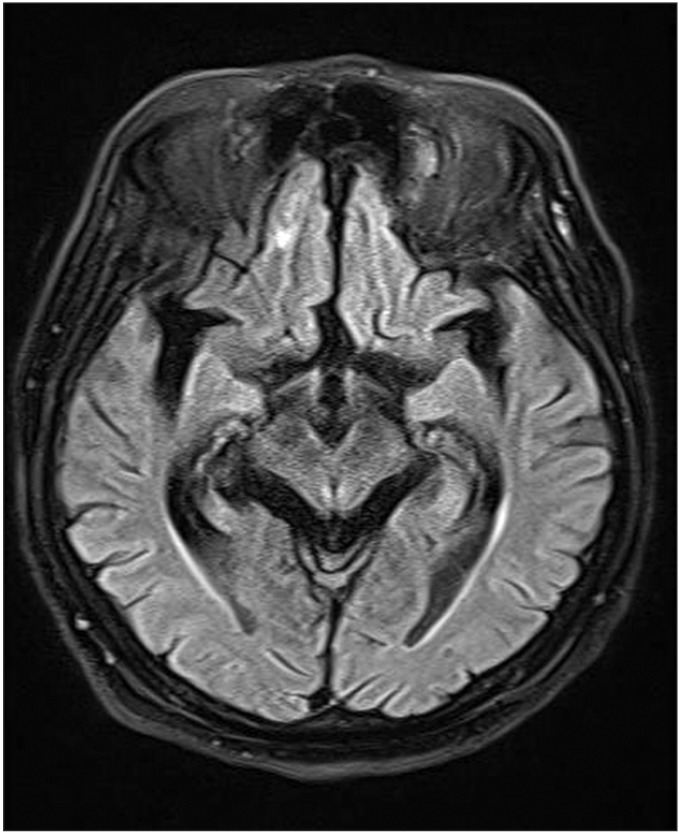Ann Rehabil Med.
2017 Feb;41(1):162-166. 10.5535/arm.2017.41.1.162.
Repetitive Transcranial Magnetic Stimulation for Wernicke-Korsakoff Syndrome: A Case Report
- Affiliations
-
- 1Department of Rehabilitation Medicine, Eulji University Hospital, Eulji University School of Medicine, Daejeon, Korea. jylimmd@eulji.ac.kr
- 2Department of Rehabilitation Medicine, Eulji Hospital, Eulji University School of Medicine, Seoul, Korea.
- KMID: 2383692
- DOI: http://doi.org/10.5535/arm.2017.41.1.162
Abstract
- A 57-year-old man who was diagnosed with Wernicke-Korsakoff syndrome showed severe impairment of cognitive function and a craving for alcohol, even after sufficient supplementation with thiamine. After completing 10 sessions of 10 Hz repetitive transcranial magnetic stimulation (rTMS) at 100% of the resting motor threshold over the left dorsolateral prefrontal cortex, dramatic improvement in cognitive function and a reduction in craving for alcohol were noted. This is the first case report of the efficacy of a high-frequency rTMS in the treatment of Wernicke-Korsakoff syndrome.
MeSH Terms
Figure
Reference
-
1. Thomson AD, Guerrini I, Marshall EJ. The evolution and treatment of Korsakoff's syndrome: out of sight, out of mind? Neuropsychol Rev. 2012; 22:81–92. PMID: 22569770.2. Kopelman MD, Thomson AD, Guerrini I, Marshall EJ. The Korsakoff syndrome: clinical aspects, psychology and treatment. Alcohol Alcohol. 2009; 44:148–154. PMID: 19151162.
Article3. Guse B, Falkai P, Wobrock T. Cognitive effects of high-frequency repetitive transcranial magnetic stimulation: a systematic review. J Neural Transm (Vienna). 2010; 117:105–122. PMID: 19859782.
Article4. Bellamoli E, Manganotti P, Schwartz RP, Rimondo C, Gomma M, Serpelloni G. rTMS in the treatment of drug addiction: an update about human studies. Behav Neurol. 2014; 2014:815215. PMID: 24803733.
Article5. Isenberg-Grzeda E, Kutner HE, Nicolson SE. Wernicke-Korsakoff-syndrome: under-recognized and under-treated. Psychosomatics. 2012; 53:507–516. PMID: 23157990.
Article6. Nardone R, Holler Y, Storti M, Christova M, Tezzon F, Golaszewski S, et al. Thiamine deficiency induced neurochemical, neuroanatomical, and neuropsychological alterations: a reappraisal. ScientificWorldJournal. 2013; 2013:309143. PMID: 24235882.
Article7. Brady KT, Gray KM, Tolliver BK. Cognitive enhancers in the treatment of substance use disorders: clinical evidence. Pharmacol Biochem Behav. 2011; 99:285–294. PMID: 21557964.
Article8. Mishra BR, Nizamie SH, Das B, Praharaj SK. Efficacy of repetitive transcranial magnetic stimulation in alcohol dependence: a sham-controlled study. Addiction. 2010; 105:49–55. PMID: 20078462.
Article
- Full Text Links
- Actions
-
Cited
- CITED
-
- Close
- Share
- Similar articles
-
- A Case of Wernicke-Korsakoff Syndrome Associated with Hyperemesis Gravidarum
- Wernicke-Korsakoff Syndrome Associated with Hyperemesis Gravidarum
- A case of Wernicke-Korsakoff syndrome associated with severe hyperemesis gravidarum
- A Case of Wernicke - Korsakoff Syndrome Associated with Hyperemesis Gravidarum
- Repetitive Transcranial Magnetic Stimulation for Limb-Kinetic Apraxia in Parkinson's Disease



